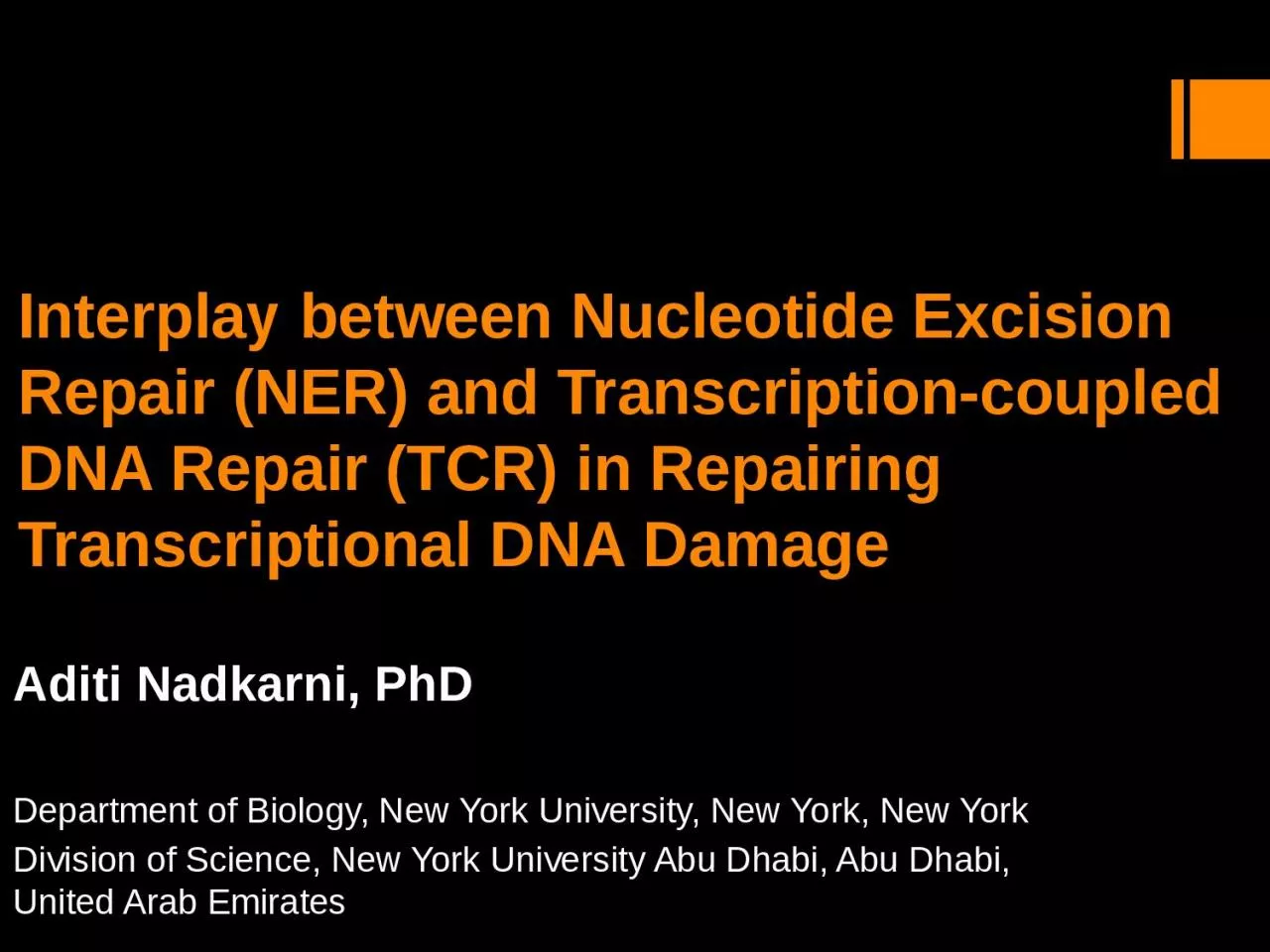

R epairing Transcriptional DNA Damage Aditi Nadkarni PhD Department of Biology New York University New York New York Division of Science New York University Abu Dhabi Abu Dhabi United Arab Emirates ID: 1039618
Download Presentation The PPT/PDF document "Interplay between Nucleotide Excision Re..." is the property of its rightful owner. Permission is granted to download and print the materials on this web site for personal, non-commercial use only, and to display it on your personal computer provided you do not modify the materials and that you retain all copyright notices contained in the materials. By downloading content from our website, you accept the terms of this agreement.
1. Interplay between Nucleotide Excision Repair (NER) and Transcription-coupled DNA Repair (TCR) in Repairing Transcriptional DNA DamageAditi Nadkarni, PhDDepartment of Biology, New York University, New York, New YorkDivision of Science, New York University Abu Dhabi, Abu Dhabi, United Arab Emirates
2. DNA DamageCancerDevelopmental DiseasesAging
3. Nucleotide Excision RepairDisrupted base pairingDetected by XPC-hR23B, in conjunction with other factorsExcision of DNA containing damaged baseXeroderma pigmentosum (XP): cancer susceptibility, sensitivity to sunlightTranscription-coupled DNA RepairDamage that blocks gene transcriptionStalled RNA polymerase II detectionExcision and repair as in NERCockayne Syndrome (CS): developmental defects
4. B[a]P-N6-dA and B[c]Ph-N6-dAMajor helical distortionNominal helical distortionCai Y, Geacintov NE, and Broyde S (2012) Biochemistry 51, 1486-1499
5. B[a]P-N6-dA versus B[c]Ph-N6-dAEffects on TranscriptionB[a]P-N6-dAUnknown effect on RNA polymerase II elongation in vitroB[c]Ph-N6-dABlocks RNA polymerase II elongation in vitroSchinecker TM, et al. (2003) Nucleic Acids Res. 31, 6004-6015
6. Does B[a]P-N6-dA block RNA polymerase II in vitro as well? If it does, it should be a substrate for TCR.
7. Site-specific DNA Template for in vitro TranscriptionConstructed by annealing a site-specifically modified 11 base oligomer, and 96 base and 90 base oligomers to a DNA element containing the CMV promoter enhancerIncubated with HeLa nuclear extract with radioactive nucleotides; RNA products resolved by denaturing PAGEInterruption of RNA polymerase II elongation is indicated by the presence of truncated transcriptsPerlow RA, et al. (2003) Nucleic Acids Res., 31, e40-e40
8. B[a]P-N6-dA Blocks Human RNA Polymerase IIMoinuddin Chowdhury
9. What is the effect of B[a]P-N6-dA or B[c]P-N6-dA on gene expression in human cells with varying DNA repair backgrounds?
10. Plasmid Reporter SystemJohn Burns, PhD
11. Effects of DNA Adducts on Transcription in Cells with Varying DNA Repair Backgrounds control vector (); B[a]P-N6-dA vector (); B[c]Ph-N6-dA vector (). p<0.02p<0.02p<0.03p<0.05p<0.04p<0.01
12. * p < 0.001Effects of DNA Adducts on Red Fluorescent Protein in Cells with Varying DNA Repair Backgrounds
13. Deep Sequencing of RNA Resulting from Transcription Past B[a]P-N6-dA or B[c]Ph-N6-dA in CellsPreliminary Data
14. Summary of transcriptional mutations due to B[a]P-N6-dA and B[c]Ph-N6-dACell typeB[a]P-N6-dAB[c]Ph-N6-dA MisincorporationsDeletionsInsertionsMisincorporationsDeletionsInsertionsNormalNER and TCR proficientLow--Low--XPANER and TCR deficientHighModerate-HighHighModerateXPCNER deficientModerateLow-LowLow-CSBTCR deficientModerate--LowModerateLow
15. B[a]P-N6-dAB[c]Ph-N6-dAPolycyclic Aromatic HydrocarbonsTCRNERTCRProposed Model
16. Conclusions and SignificanceBulky DNA adducts encountered during transcription block RNA polymerase II elongationTCR abrogates the deleterious impact of DNA lesions that can escape NERWhy are these findings significant?
17. Historical & salient findings in the field
18. AcknowledgementsDavid A. Scicchitano, PhD: Principal InvestigatorNational Institutes of Health Grant ES-010581 to DAS and funds from New York University Abu Dhabi to DAS.
19. 1John Burns, PhD3,4Alberto Gandolfi, PhD 1Moinuddin Chowdhury, MS 2Nicholas Geacintov, PhD Mathematical modeling and statistical analysisIn vitro transcription assaySite-specific oligonucleotides1Suse Broyde, PhD1Yuqin Cai, PhD Technical consultation; previous studies showing structural models of DNA adducts5Christian Berens, PhD Parental plasmid for gap duplex systemAcknowledgements1: Department of Biology, New York University, New York, New York2: Department of Chemistry, New York University, New York, New York3: Division of Sciences, New York University Abu Dhabi, Abu Dhabi, United Arab Emirates4: Dipartimento di Matematica e Informatica “Ulisse Dini”, Università di Firenze, Firenze, Italia 5: Institute of Molecular Pathogenesis, Friedrich-Loeffler-Institut, Jena, Germany
20. Thank you
21.
22.
23. Gap duplex technology